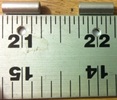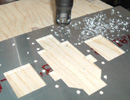


random user submitted photo
Gross Weight Advisory (LSA Compliance) [Sonextalk, 1.16.13]
1 post
• Page 1 of 1
Gross Weight Advisory (LSA Compliance) [Sonextalk, 1.16.13]
Gross Weight Advisory (LSA Compliance and Safety) [Sonextalk, 1.16.13]
[All Airframes]
All Sonex eGroups:
GROSS WEIGHT ADVISORY (LSA Compliance and Safety):
Notice to all Sonex Aircraft builders: exceeding the max gross weight
published for your Sonex Aircraft can have many negative consequences,
including the disqualification of the aircraft as a Light Sport Aircraft
(LSA). Anyone considering an increase in their aircraft’s gross weight due
to modifications to the aircraft, the use of alternative engines, or a
desire to increase useful load, should take notice of the following
important considerations:
The Sonex and Waiex have a design gross weight of 1150 pounds if powered by
a 120 horsepower engine and an 1100 pound gross weight if powered by an 80
horsepower engine. These gross weights are based on power loading as well as
wing loading. Aircraft powered by the 120 hp Jabiru 3300 have the
power-loading margin to carry an additional 50 pounds and still retain the
climb performance we seek, without exceeding the wing loading requirements
for these aircraft to be Light Sport compliant. The Onex also has a gross
weight limit (950 lbs) that matches the aircraft’s wing loading to keep the
aircraft LSA compliant.
Under no circumstances do we endorse licensing the aircraft above our
published limits. Any Sonex Aircraft licensed above those limits is not
Light Sport (LSA) compliant as the wing loading exceeds the allowable wing
loading for a Light Sport aircraft. Sonex Aircraft licensed above our
published weights can only be flown by a pilot who holds a Private Pilot
license with a current 3rd class, or greater, medical regardless of the
actual weight during any particular flight.
Additionally, operating at gross weights above our published limits degrades
the aircraft's performance (climb rate, take-off/landing distance, stall
speed, etc. may be effected) and reduces the margin of safety when G-loads
are experienced. Airframe components may also see increased wear or reduced
service life as they are subjected to loads for which they were not
designed.
Randomly assigning a higher gross weight to any aircraft may have many
unanticipated implications and is never an acceptable "fix" for an aircraft
that has been made heavy through builder modifications.
When discussing the AIRCRAFT, manufacturers use two terms. S-LSA
(Special-Light Sport Aircraft, ready to fly aircraft) or E-LSA
(Experimental-Light Sport Aircraft, advanced kits or flying aircraft that
comply with the ASTM LSA Standards). These terms do not exist in the Sonex
world since we do not have either an E-LSA or S-LSA Aircraft Offering.
(Note that you may come across a Sonex that was licensed as an E-LSA during
the brief "grandfathering" window offered by the FAA for fat/training
ultralights from 2006 into 2007. This window is now closed).
When discussing the PILOT, manufacturers typically use the terms "Light
Sport Aircraft (LSA)" or "Sport Pilot Compliant". This refers to any
aircraft that a Sport Pilot is able to fly regardless of where it came
from...Production Aircraft, Kit Aircraft, Plans-Built Aircraft, etc.
There is nothing in the FARs or ASTM LSA Design Standards that state a
specific weight-to-wing area number that aircraft must comply with. The
issue of Sport Pilot Compliance for a particular aircraft comes from the
clean stall speed number. The higher the gross weight, the higher the stall
speed. In our experience this relationship is not necessarily linear. It
must be thoroughly and scientifically measured to ensure compliance.
Since the Sonex prototype aircraft have NOT been designed to or flight
tested at a greater than 1150 lb gross weight, it is up to the builder to
prove Sport Pilot (LSA) compliance if gross weight is arbitrarily set
higher. Randomly assigning a higher gross weight to any aircraft may have many unanticipated implications and is never an acceptable "fix" for an aircraft that has been made heavy
through builder modifications. We strongly encourage you to think long and
hard before adding any weight to your aircraft.
As always, please feel free to contact any member of the Sonex Team at the
numbers or e-mail below with any questions or Comments.
Regards,
-Sonex Aircraft, LLC
--
www.sonexaircraft.com
Tel (Info/Orders): 920.231.8297
Tel (Tech Line): 920.230.8324
Fax: 920.426.8333
Sonex Aircraft, LLC's Mission is to provide the recreational aviation
community innovative, cost-effective and efficient aircraft kits,
powerplants, and accessories and support them with industry-leading customer
service.
In addition, Sonex provides leadership to the grass-roots homebuilt
community to protect the experimental-amateur built rules and cultivates new
pilots and airplane builders through educational efforts.
Web Store: http://www.sonexaircraft.com/eshop/
Please use the following e-mails to Contact Sonex Aircraft:
Sales Info: sales@sonexaircraft.com
Orders: orders@sonexaircraft.com
Accounting: accounting@sonexaircraft.com
Tech Support: tech@sonexaircraft.com
This email message and all attachments may contain legally privileged and
confidential information intended solely for the use of the addressee. If
you are not the intended recipient, stop reading this message and delete it
from your system. Any unauthorized reading, distribution, copying or other
use of this message or its attachments is strictly prohibited.
[All Airframes]
All Sonex eGroups:
GROSS WEIGHT ADVISORY (LSA Compliance and Safety):
Notice to all Sonex Aircraft builders: exceeding the max gross weight
published for your Sonex Aircraft can have many negative consequences,
including the disqualification of the aircraft as a Light Sport Aircraft
(LSA). Anyone considering an increase in their aircraft’s gross weight due
to modifications to the aircraft, the use of alternative engines, or a
desire to increase useful load, should take notice of the following
important considerations:
The Sonex and Waiex have a design gross weight of 1150 pounds if powered by
a 120 horsepower engine and an 1100 pound gross weight if powered by an 80
horsepower engine. These gross weights are based on power loading as well as
wing loading. Aircraft powered by the 120 hp Jabiru 3300 have the
power-loading margin to carry an additional 50 pounds and still retain the
climb performance we seek, without exceeding the wing loading requirements
for these aircraft to be Light Sport compliant. The Onex also has a gross
weight limit (950 lbs) that matches the aircraft’s wing loading to keep the
aircraft LSA compliant.
Under no circumstances do we endorse licensing the aircraft above our
published limits. Any Sonex Aircraft licensed above those limits is not
Light Sport (LSA) compliant as the wing loading exceeds the allowable wing
loading for a Light Sport aircraft. Sonex Aircraft licensed above our
published weights can only be flown by a pilot who holds a Private Pilot
license with a current 3rd class, or greater, medical regardless of the
actual weight during any particular flight.
Additionally, operating at gross weights above our published limits degrades
the aircraft's performance (climb rate, take-off/landing distance, stall
speed, etc. may be effected) and reduces the margin of safety when G-loads
are experienced. Airframe components may also see increased wear or reduced
service life as they are subjected to loads for which they were not
designed.
Randomly assigning a higher gross weight to any aircraft may have many
unanticipated implications and is never an acceptable "fix" for an aircraft
that has been made heavy through builder modifications.
When discussing the AIRCRAFT, manufacturers use two terms. S-LSA
(Special-Light Sport Aircraft, ready to fly aircraft) or E-LSA
(Experimental-Light Sport Aircraft, advanced kits or flying aircraft that
comply with the ASTM LSA Standards). These terms do not exist in the Sonex
world since we do not have either an E-LSA or S-LSA Aircraft Offering.
(Note that you may come across a Sonex that was licensed as an E-LSA during
the brief "grandfathering" window offered by the FAA for fat/training
ultralights from 2006 into 2007. This window is now closed).
When discussing the PILOT, manufacturers typically use the terms "Light
Sport Aircraft (LSA)" or "Sport Pilot Compliant". This refers to any
aircraft that a Sport Pilot is able to fly regardless of where it came
from...Production Aircraft, Kit Aircraft, Plans-Built Aircraft, etc.
There is nothing in the FARs or ASTM LSA Design Standards that state a
specific weight-to-wing area number that aircraft must comply with. The
issue of Sport Pilot Compliance for a particular aircraft comes from the
clean stall speed number. The higher the gross weight, the higher the stall
speed. In our experience this relationship is not necessarily linear. It
must be thoroughly and scientifically measured to ensure compliance.
Since the Sonex prototype aircraft have NOT been designed to or flight
tested at a greater than 1150 lb gross weight, it is up to the builder to
prove Sport Pilot (LSA) compliance if gross weight is arbitrarily set
higher. Randomly assigning a higher gross weight to any aircraft may have many unanticipated implications and is never an acceptable "fix" for an aircraft that has been made heavy
through builder modifications. We strongly encourage you to think long and
hard before adding any weight to your aircraft.
As always, please feel free to contact any member of the Sonex Team at the
numbers or e-mail below with any questions or Comments.
Regards,
-Sonex Aircraft, LLC
--
www.sonexaircraft.com
Tel (Info/Orders): 920.231.8297
Tel (Tech Line): 920.230.8324
Fax: 920.426.8333
Sonex Aircraft, LLC's Mission is to provide the recreational aviation
community innovative, cost-effective and efficient aircraft kits,
powerplants, and accessories and support them with industry-leading customer
service.
In addition, Sonex provides leadership to the grass-roots homebuilt
community to protect the experimental-amateur built rules and cultivates new
pilots and airplane builders through educational efforts.
Web Store: http://www.sonexaircraft.com/eshop/
Please use the following e-mails to Contact Sonex Aircraft:
Sales Info: sales@sonexaircraft.com
Orders: orders@sonexaircraft.com
Accounting: accounting@sonexaircraft.com
Tech Support: tech@sonexaircraft.com
This email message and all attachments may contain legally privileged and
confidential information intended solely for the use of the addressee. If
you are not the intended recipient, stop reading this message and delete it
from your system. Any unauthorized reading, distribution, copying or other
use of this message or its attachments is strictly prohibited.
- sonexpilot
- Posts: 9
- Joined: Mon Mar 24, 2014 9:17 pm
1 post
• Page 1 of 1
Return to Sonex Aircraft, LLC Posts
Who is online
Users browsing this forum: No registered users and 14 guests







